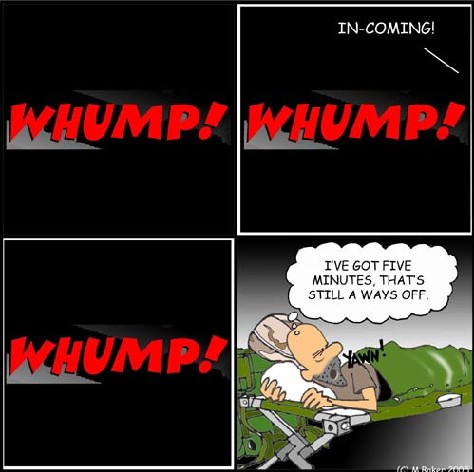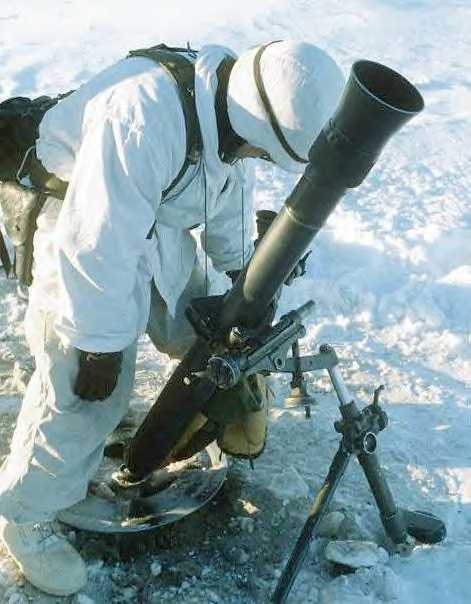
MAN-CART DISMOUNTED MORTARS, NOT MAN-PACK: SMALL UAVS BELONG WITH MORTAR CREWS

Falkland Islands War, 1982
Their ships sunk carrying their Chinook helicopters, British Royal marines will not be able to "Air-mobile" anywhere. They will have to march. Their ships cannot venture close enough to give 5" gun naval gunfire support without being hit by anti-shipping missiles (ASMs) and sunk like the HMS Glamorgan. The British 2rd and 3rd Paratrooper battalions were already expected this and are "yomping" across carrying their own pocket firepower: mortars. It takes 50 men to move just two 81mm medium mortars and their units of fire for one battle--a short one. At Goose Green, 2nd Para fights with only what it can carry-no light tanks--and it takes their Battalion Commander winning the Victoria Cross to decide the issue. British casualties are not light, their courage and Soldier's loads---heavy.
In response to the bitter fighting that resulted from the slow ship deployment of British troops to the South Atlantic which gave the Argentines time to reinforce, dig-in and lay mines, the Ministry of Defense created the first the 5th and now the 16th Airborne Brigade that can now fly to a world hot spot like the Falklands within hours. Hopefully detering aggression in the first place like the British Airborne as a full-sized Division did to stop Iraq invading Kuwait in 1961.
"Under extreme circumstances, the commander may choose to leave one of the section's mortars behind and have more ammunition carried for the remaining mortar. This could occur during operations over deep snow, requiring the mortar section to use ahkios to transport its weapons and equipment. The six-man mortar section can pull only a single ahkio, which can carry up to 200 pounds. Operations on mountainous terrain can also cause the commander to choose to leave a mortar behind. During assault climbs or infiltration attacks over rough terrain, the efforts of all six mortarmen may be needed just to get a single mortar and its ammunition into a firing position.
The section sergeant and company commander consider how much ammunition is carried and who carries it. The mortar section can carry only a limited amount of ammunition. The approach load of mortarmen must be kept to a minimum. Extra pounds of personal equipment decrease the ammunition carried by the section. In World War II, the gunner of the 60-mm mortar squads carried the mortar tube and six rounds. Two other members of the squad carried 12 rounds each. This represents only one minute of fire at the maximum rate for the 60-mm mortar. The company commander's options for carrying more mortar rounds are limited.
Each member of the rifle platoons and company headquarters can carry one or two mortar rounds. This adds weight to the already heavy load of the riflemen and machine gunners, but it does ensure that mortar ammunition is available. This method is hard to control if the enemy opposition is intermittent but can be effective during a deliberate attack. As the rifle platoons pass through or near the proposed mortar firing position, they can drop their mortar rounds. A modification of this method was used in the Korean War when attacks were being made along or up steep ridge lines. The lead rifle platoons did not carry any mortar rounds. The mortar section moved second in the line of march, carrying as much ammunition as it could. The second and third rifle platoons, moving behind the mortars, carried one or two rounds on each man. When enemy contact was made, the leading platoon immediately began the assault, supported by the mortar section firing the ammunition it carried. As each succeeding rifle platoon passed the mortar position, it dropped its mortar rounds and joined the attack.
The rifle company can have the mortar section carry as much ammunition as possible and rely on vehicles, aircraft, or battalion-carrying parties to resupply ammunition. This method works best when the advance is along a road net or over trafficable terrain. Organic vehicles may be used, or captured enemy equipment may be pressed into service. A method that saves time and effort is to have mortar ammunition broken out of its boxes either at the ammunition transfer point or unit trains. The individual canisters can then be placed into color-coded aviator kit bags and stockpiled for movement forward by the available transportation means. Using the kit bag eases loading, unloading, and transferring the ammunition. About 15 rounds of ammunition can be carried in each kit bag, making a load that can be handled easily by two men, or by one man in an emergency. In some areas of the world, labor service units provided by our allies can carry ammunition. In the lesser developed countries, indigenous pack animals may be available. If carrying parties or pack animals are used, the company XO and first sergeant must coordinate to ensure that guides and drivers/handlers are available and supervised.
The rapidly employable, lightweight litter referred to as the SKEDS litter can also be used to move mortar ammunition and equipment. One man can pull a fully loaded SKEDS litter out of a helicopter and over most types of terrain for short distances."
FM 7-90 Mortars Chapter 8 Light Mortars
BG William O. Darby wrote in, We Lead the Way pages 130-131:
For the Sorrento Peninsula and its mountain fighting, there was an evident need for extra mortar ammunition, so each Ranger carried one round of 60-mm ashore with him on the landing. The first men to leave the boats were unencumbered with heavy equipment. Each carried one extra bandolier of ammunition around his neck; as soon as he hit the beach he threw it off above the high watermark. The last four men out of the boat carried the cases of mortar and small arms ammunition. When they passed the high watermark on the beach, they simply dropped their loads and kept going. The beach naturally looked like a junk yard when morning came, but the second wave's supply officer straightened it out...
Operating in high mountains that rose sharply as high as several thousand feet, the mortar battalion had to improvise or find means of carrying their ammunition. The Chemical Warfare Service had built a small cart exactly fitting the ramp on the LCI. These carts, loaded with ammunition, were pulled ashore down the ramps of the boats..."
Colonel David Hackworth (Ret.) writes in to 1st Tactical Studies Group (Airborne) Director, Mike Sparks:
ITS TIME FOR A SOLUTION: ATACS
First off get mortar rounds out of the individual Paratrooper's rucksacks. If they ever carry mortar rounds they need to be rapidly accessible without need of a sling that has to be turned into supply--use commo wire as Col. Hackworth suggests. The 2 mortars sections jump their M224 60mm mortar components inside M1950 weapons cases or the new AirPack weapons case with simultaneous quick release of ruck and case for extreme low-level jumping. Details covered in the 1996 FM 57-220 Military Static-line parachuting manual here. They carry in their rucks a minimum load of 60mm ammo for immediate return fire capability. The rest of the Infantry Company will be spread too far out in an immediate firefight from the DZ to get their mortar rounds in their rucks to the 60mm mortar sections, so all they do is hinder the mobility of those that need to maneuver to get killing direct fire on the enemy.
Before each mortar section jumps, a A-21 door bundle with a piece of truck bed liner plastic on the bottom is pushed out with a T-10 cargo parachute to match the descent profile of the jumpers. The directional ribs on the truck bed liner plastic insure the bundle slides out the door but not back against the trailing edge and get stuck. Truck bed liner plastic has been donated by the efforts of the 1st TSG (A) to the U.S. Army Airborne Special Operations Test Directorette at Fort Bragg, NC. SKEDCO plastic can also be cut to help door bundles exit properly. The mortar Paratroopers jump immediately afterwards.
The mortar Paras get out of their parachutes, ruck up and move to their door bundles. Inside are 50 rounds of 60mm ammo and an All-Terrain All-Purpose Cart or ATAC. They assemble the ATAC with the wheels placed in the center for center of balance and load the mortar rounds inside. One Para tows the ATAC hands-free to aim and fire a weapon with a waist belt. Upon enemy contact a quick release frees him to return fire and IMT. This cart should be the field-proven UT 2000 system in use by dozens of Allied Armies worldwide with fat tires for low ground pressure. If the mortar section encounters terrain not passable by the ATAC, they can disassembled it into two pack frames and spread the ammo out into man-sized loads, though the UT 2000 will roll or slide over anywhere. Without wheels, the UT 2000 is a snow sled. But unlike an Akhio, only one man needs to tow it, so each section can have one. In fact, its possible with ATACs to upgrade the light mortar section to 81mm or even 120mm mortars though both should be moved by either John Deere Para-Gator or HMMWV 4x4 vehicles. Light tanks like the M8 Ridgway Armored Gun System and M113 Gavins should have a M224 60mm mortar (can be trigger-fired, point-aimed) on their turret sides like the IDF Merkava I tanks have to give indirect fire support in situations where direct fire from its main gun is not possible. Its quite easy for a tracked AFV to carry several cases of mortar ammo in its turret bustle rack that would require immense toil to man-carry. Mortar tubes should be carried "back-pack-style" using double-slings to keep them away from the legs for better foot mobility. ATACs could carry the new generation of "smart" guided mortars that can kill tanks.
"2 Para came within an ace of failure as, nearing exhaustion, outnumbered, low on ammunition, and lacking adequate fire support, they fought over open ground, and in daylight, against prepared positions.... was the battle necessary at all? Why did London overrule the brigade commander's reluctance to attack Goose Green? Did Colonel 'H' Jones's solo charge on Darwin ridge--which won him a posthumous VC--decide the issue? Goose Green was the first land battle of the war. It was also the longest, the hardest-fought, the most controversial, the most important to win, and the only one that hung in the balance for several hours.."
"Britain's Airborne rapid development force, 5th Airborne Brigade was setup in its present form after the Falklands War to deal with Out of Area Operations (O.A.O.). Which could be rapid reinforce of dependent territories; the evacuation of United Kingdom nationals from overseas trouble spots; assistance to friendly governments; international peace keeping operations and rapid response to emergencies."
U.S. Airborne and Light Infantry forces have been (Somalia, Vietnam) and are in the same predicament: no more Iowa Class battleships with 16 inch naval guns. The Navy staying over the horizon (OTH) to keep from being sunk by anti-ship and cruise missiles. Light tanks cancelled and light AFVs like the 11-ton M113A3 Gavins not taken to the fight even though they weigh exactly the same as 22,000 pound FMTV trucks that are instant RPG "road kill" due to institutional narrow-mindedness. 90mm Recoilless Rifles retired. 106mm RRs in storage unused. LAWs/AT4s not taken into the field and even constructively used in field exercises to volley fire for shock effect. Their only organic indirect firepower: manpack 60mm and 81mm mortars. But their mobility outlook with even light 60 mm mortars is almost as bleak as the Brits with 81mm medium ones.
"If it hadn't been for our standard operating procedure of carrying extra mortar shells ashore in the assault boats, we might have lost our hold on the Sorrento Peninsula...
"Back when the 60 was gone and replaced by the 81, I had each trooper carry one round with a como wire sling. When they got into a fight they dropped the rds. It always found its way back to the guns or its carrier. It worked. Did the same thing with a box of 30 cal ammo in korea. My outfit was always ready for bear."

The official U.S. Army Quartermaster Air-delivery web site says this about the carts they parachuted into our men in WWII:
"Similarly, two wheeled ammunition carts were found to be too bulky to load and too large to drop through the plane door. Mechanics of the unit simply sliced the wagons into manageable sections, fitted them with bolts and braces for re-assembly by the receiving troops, and parachuted the carts over the side."With a good ATAC with fat, not bicycle tires, that is not dead body weight--that becomes a pack frame if rolling terrain is not found, the mortar section can have its ammunition by its side for immediate use. We say a good ATAC, because the U.S. Army seems to have chosen a narrow bicycle tire cart that has its wheels in only one position instead of the UT 2000, which can also evacuate a wounded Paratrooper. Both carts are depicted in the picture below:
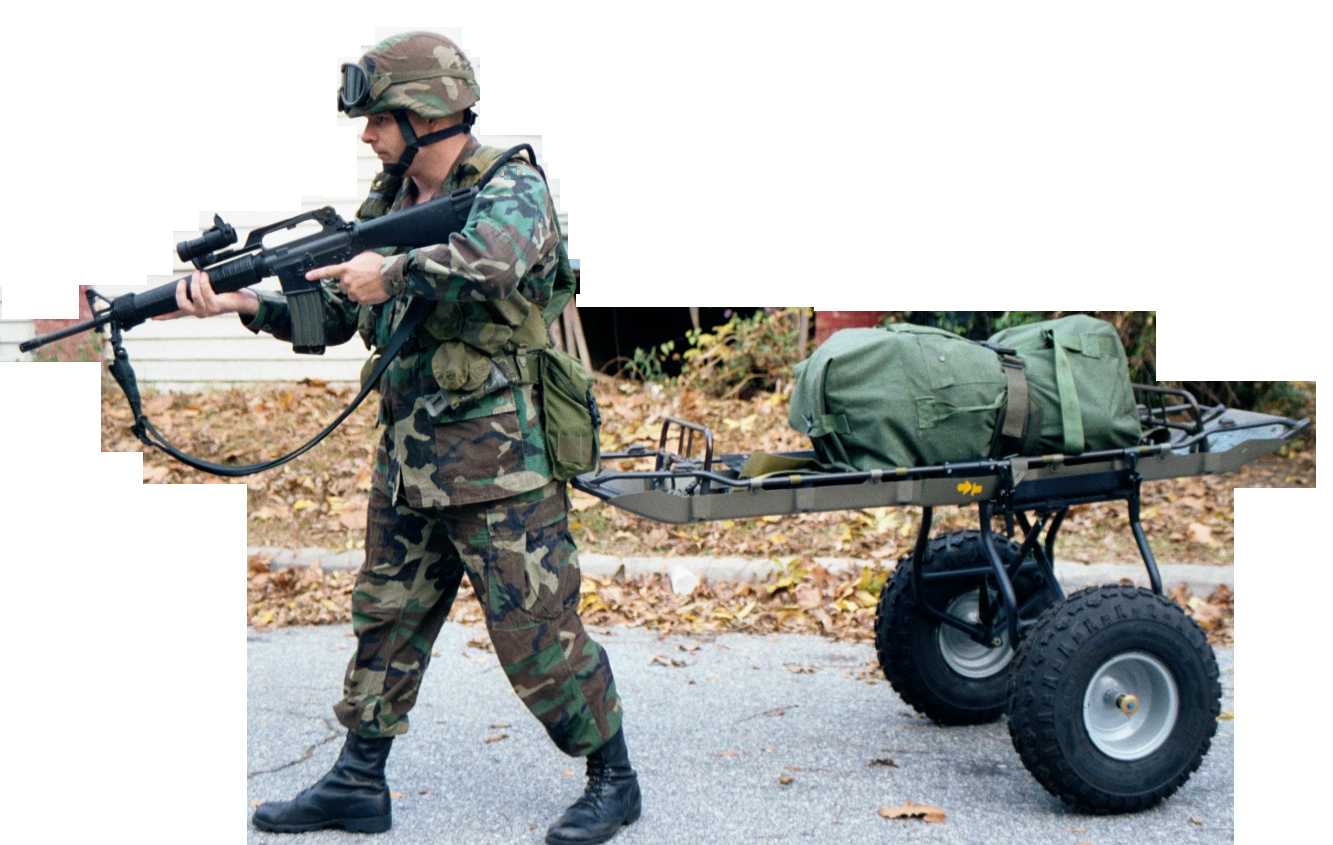
The bottom line is that local Airborne units have the purchasing power to buy inexpensive items like ATACs at their level. We encourage them to do this. POC information is below:
The Darby All Terrain All-purpose Cart/Sled (ATACS) is a combination of the UT2000 stretcher, used by dozens of allied armies made by originally by Kohlbrat & Bunz of Cornelius, NC (704) 896-1999 but now FERNO that is actually two cargo backpack frames that join to be a helicopter evacuation Stokers litter, Snow Sled, ground litter and with All-Terrain Wheels a one-man propelled ammunition, equipment, casualty evacuation cart and the Roleez Corp., low-ground pressure tire system. There is no dead weight in this system: if it cannot be rolled, it splits into cargo backpacks to carry the mission items.
The U.S. Army Airborne and light forces in the XVIII Airborne Corps are America's "first-to-fight" since we are a strategic AIR power. Everything we can do to enhance war winning combat power to the Paratrooper is of vital urgency to our national security and the defense of freedom. In this case, the ATACs need to be obtained, rigging procedures for A-21 door bundles decided upon and field SOPs determined. The rest is VICTORY.
U.S. Army Saves marines in Iraq; gyrene Bureaucracy Refuses to arm its own UAVs...
ScanEagle
The USMC being too stupid and lazy to operate their own Unmanned Air Vehicles (UAVs) and whose pilots are too egotistical to fly manned observation/attack (O/A) aircraft (hence they retired their OV-10 Broncos in the 1990s) are losing men and limbs to land mines so they hired smart civilians to do their job. This privatization of war favored by fascist Nazi Neocon types like former Secretary of Defense Donald Rumsfeld is a Band-Aid covering up the corruption within the U.S. military which is a BUREAUCRACY--and not a PROFESSION.
Rummy's Day-before-9/11 Freudian Privatization Slip
www.defense.gov/speeches/speech.aspx?speechid=430
Having company-owned and company-operated (COCO) war means is a work-around that ignores the problem that our military isn't a profession--but needs to be one--where smart people are rewarded--not driven to frustration by prevailing mediocrity and hive-mindedness.
More Reasons Why UAVs Suck, You May not Know About...
It's well known that UAVs have a limited "soda straw" field-of-view and rebels can easily evade them. Improving sensors will help, but the best "sensor" is trained observer humans who know their "beat" down below and can use their Mark 1 eyeballs with stabilized binoculars PLUS SENSORS to ferret out the enemy from civilians. This is why we have USAF and Army RC/MC-12 Liberty turboprop sensor aircraft coming into service. However, RC/MC-12s are not ARMED to take immediate action to spoil enemy attacks and ambush preparations.
www.defensenews.com/osd_story.php?sh=VSDP&i=4142686
PARIS - King Air 350 builder Hawker Beechcraft is studying the possibility of fitting out the aircraft with precision-guided weapons as one option to extend the platform's capabilities.
The King Air ISR plane on static display at the Paris Air Show. (Andrew Chuter / Staff) Terry Harnell, the Hawker vice president for special mission aircraft, said the company was looking at designing wing hardpoints capable of carrying small precision weapons, electronic sensor pods or external fuel tanks to make the King Air more versatile.
The Hawker executive said the idea had created a great deal of interest, although the company was not under contract to provide an aircraft with underwing hardpoints.
For this, we need armed O/A aircraft that can dive or at the very least, strafe with long-range cannon mounted on the belly in a turret. Guided missiles will also work, but are expensive.
Another problem with most UAVs is they have long, thin glider wings and cannot fight adversary winds to get to where they are needed in a hurry; resulting in a lack of air surveillance by nothing being on-station. Small hand-launch, electric-powered UAVs cannot operate without crashing in the mountains of places like Afghanistan and this fear resulted in them not being used by the Soldiers at Combat Outpost Kahler--which was later surprise fire attacked by the enemy during the 2008 battle for adjacent Wanat village, resulting in 9 Paratroopers dying needlessly. This tragedy cries out for small aerostat balloons or even towers--to render surveillance dominance around the general perimeter "inner circle". For the "outer circle" an UAV that can fly in the face of strong winds is needed.
combatreform.org/CALL-Wanat-Final-Report.pdf
An UAV in Hand Beats...NOTHING in the bush...
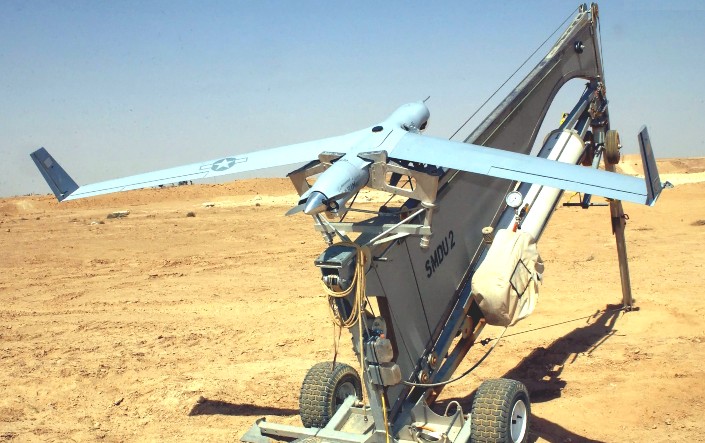
ScanEagle
Research indicates that the smallest UAV that can operate even in contrary 30 mph winds and be armed to spoil enemy attacks is the JP8 fuel-powered Boeing-InSitu ScanEagle sized aircraft that is catapult launched and recovered by flying into a line like the WW2 Brodie system used for STOL manned grasshopper aircraft.
combatreform.org/grasshoppersmustreturn.htm
While manned O/A aircraft are the best, Soldiers need SOMETHING N-O-W that is ORGANIC to the infantry--not something at battalion--or worse brigade they will never have help them. Where should UAVs be?
UAVs Belong with the Mortar Teams

ScanEagle
With Infantry 60mm, 81mm and 120mm mortar teams.
ALL infantry mortars should be mounted in M1064A3 Gavin light tracked tanks for cross-country mobility to avoid road land mines and armor protected to deny the enemy from knocking them out if ground-mounted as took place at the COP Kahler siege. Gavin-mounted mortars are ready to return fire at high angles out to 3km (60mm), 5km (81mm) and 7km (120mm) to reach and strike enemies exploiting hilly/mountainous terrain irregularities to hide and effect surprise fire ambushes/attacks.
Proposal to use Airborne 120mm Mortars in Light Tanks
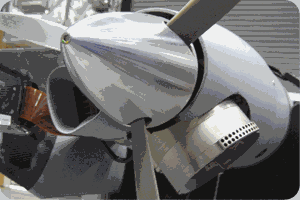
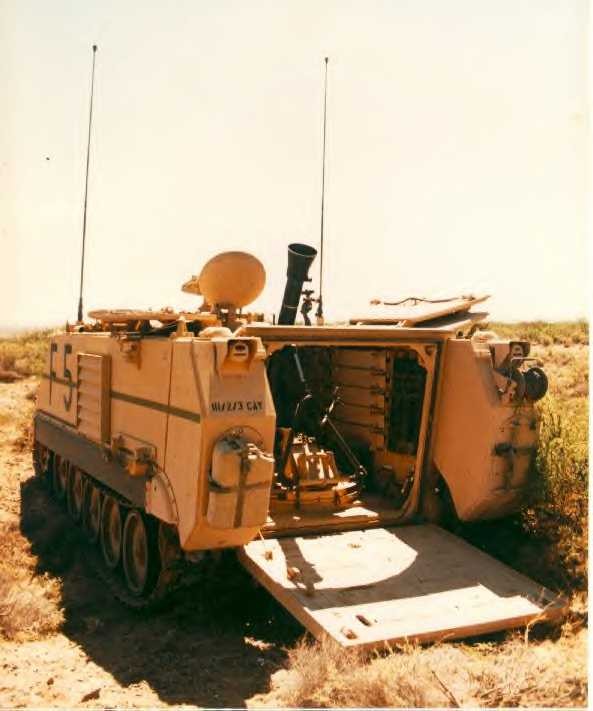
FM 3-22.90 Mortars
www.scribd.com/doc/9431563/FM-32290-Mortars
TM 9-2350-277-10/TM-9-2350-277-100078 M1064A3 Mortar Carrier
www.tpub.com/content/operatormanuals/TM-9-2350-277-10/TM-9-2350-277-100078.htm
M1064A3 GAVIN MORTAR CARRIER
This carrier is designed to carry the 4.7 inch (120-mm) Mortar M121. The mortar can be fired from a turntable in the carrier, or removed and fired from a ground base plate. The carrier has a crew of four, including the driver. The M1064A3's capabilities and features are:
It travels easily over rough terrain.
It fords water up to 40 inches (102 cm) deep. [EDITOR: it SWIMS]
It can move at high speeds on improved roads and highways.
It is air transportable and can be dropped by parachute to troops in the field.
It has an enlarged three-piece firing hatch. This permits mortar to be fired through an arc of 90 degrees over the rear of the carrier.
It has a cupola with a caliber .50 [heavy] machine gun.
It is propelled and steered on land and in water by tracks.
It has M17 periscopes around the driver's and commander's hatches for vision when buttoned up.
It has an AN/VVS-2 driver's night vision periscope stowed near the driver. The periscope can be installed in the driver's hatch to provide night vision under blackout conditions.
It can be equipped to carry an NBC (gas particulate filter) unit, a driver's windshield kit, an engine coolant heater kit, and personnel heater kit (for cold weather operation) and Mortar Fire Control System (MFCS).
The operation of the 4.7-inch (120-mm) Mortar M121 used on the M1064A3 Carrier is covered in TM 9-1015-250-10.
American light infantry A, B, C rifle companies should have M113 Gavins available with the "D" or "Dragoon" weapons company at battalion to move them and their equipment. Not only can more mortar bombs be carried by Gavin motorized, armored tracks than by foot marching, turn-tables can be on the vehicle floor for the larger 81mm and 120mm mortars or roof brackets for the 60mm mortars to fire instantly when needed in order to hit fleeting targets.
combatreform.org/itmaneuversabattalion.htm
When infantry operates dismounted on foot, it should have all-terrain, all-purpose cart/sleds or folding mountain bikes to carry ammunition, water and food:
It may also be handy to have a M224 60mm mortar with half its barrel cut-off to reduce its weight with the small square base plate to under 10 pounds to offer commando mortar capabilities as Carlton Meyer and Phil West articulate on their web pages below:
www.angelfire.com/art/enchanter/mortars.html
www.g2mil.com/West-anti-armor.htm
The South Africans have a very nice 60mm commando mortar. It has a carrying handle at its centre-of-gravity that mounts the trigger and a bubble sight. More importantly it can be carried ready-loaded.
In the event of an ambush the mortar-man simply drops the base plate to the ground, aims and fires. Unless the mortar-man is one of the first casualties, the unit can respond with mortar fire within seconds of being fired upon. While useful for a platoon, this is even more desirable for a small special operations unit that is usually out-numbered and doesn't have higher echelon support.
Another benefit of mortars being light mechanized mobile is Gavins can TOW A CATAPULT LAUNCHER with a SCAN EAGLE ON IT in a ready-to-launch "Killer bee" manner. The same JP8 fuels both the UAV and its armored towing vehicle. The imagery should be signaled back to mortar teams because they are the ones with the 360 degree directional, long-range indirect fire weapons that can exploit the targeting long before the enemy gets within 1, 000 meter machine gun direct fire range. Javelin (2 km) and TOW (3.75km) ATGMs have ranges that can exploit UAV targeting, but what the UAV sees from its bird's eye view may not be visible with a line-of-sight for these direct-fire weapons. Therefore, the most efficient and logical operators for cat-launched UAVs are mounted, light mechanized mortar teams who do not hold a portion of the defensive positional line but are a distance back from it.
Even Small UAVs Must Be Armed
How many times have we seen unarmed UAVs sending back video imagery of our men who have run-out-of-ammunition being killed by the enemy while we were powerless to do anything? SEAL light machine gunner Neal Roberts comes to mind.
Without manned O/A our men have been suffering heavy casualties in Iraq/Afghanistan from enemy land mine ambushes for over a decade now--with no end in sight. This has prompted even the marines to put 2 + 2 together and demand small UAVs be armed to at the very least spoil enemy attacks.
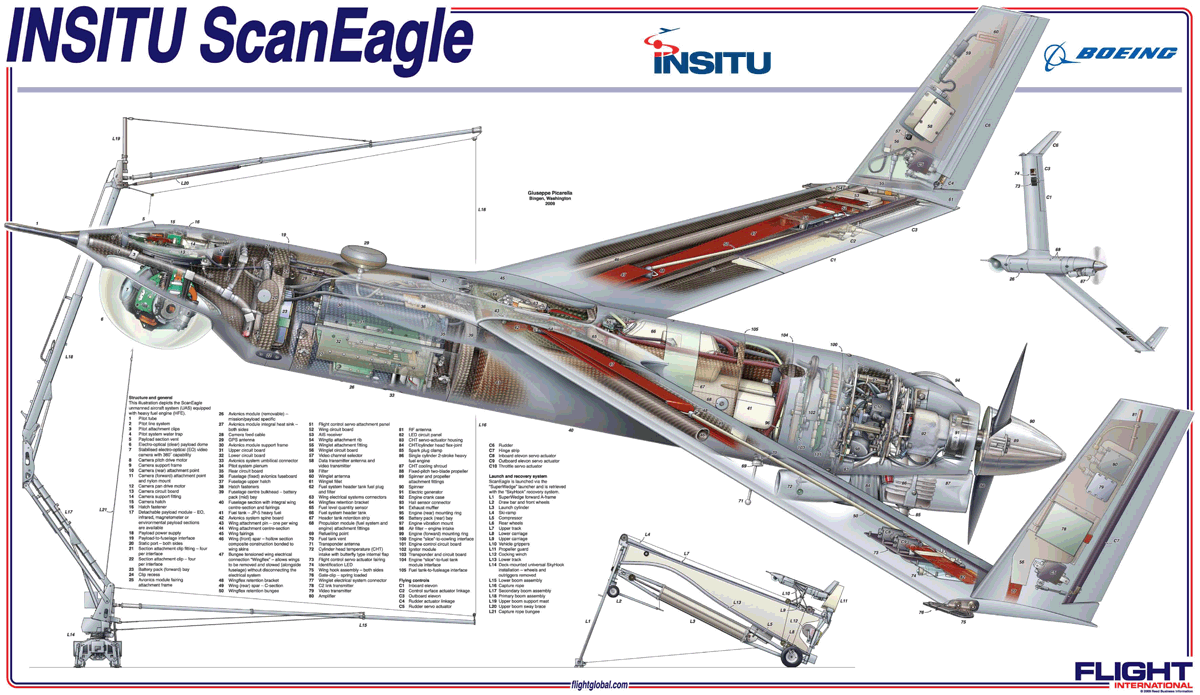
www.military.com/features/0,15240,138002,00.html
June 5, 2007
The concept is to take an existing "Tier II" medium-size drone in the vein of the 10-foot-wingspan Boeing/InSitu Scan Eagle, and fit it with two 40-millimeter grenade launchers, two green-laser dazzlers and a focused sound device similar to the Long-Range Acoustic Device manufactured by American Technology Corporation. This suite would give marine operators "escalation-of-force options," according to the briefing.
ScanEagle
In other words, the drone would be able to first warn off suspected insurgents by beaming a verbal message in Arabic. If the suspects don't disperse, the drone can dial up the intensity of its sound broadcast, causing pain and disorientation. If that doesn't work, there are the laser dazzlers, which can cause temporary blindness from up to a mile away. If, after all of this, the suspects are still behaving threateningly, the drone can fire its grenade launchers.
Marine Corps officials in western Iraq signed separate official "needs statements" requesting the drone in September and November. The request is pending at marine corps combat development command in Quantico, Virginia. But the Quantico weapons-buying bureaucracy has previously rejected scores of similar needs statements asking for a wide range of ground and air weapons.
Indeed, Quantico has earlier rejected separate requests for three of the major components of the proposed new drone. Marines in Iraq asked for additional acoustic devices for ground use and were denied. In 2005 and 2006 they repeatedly requested laser dazzlers, also for ground use, and Quantico said no, citing safety concerns. Multiple needs statements calling for hundreds of unarmed Tier II drones for surveillance missions were all ignored or turned down in favor of a planned competition for a new drone design beginning next year. The science advisors' armed drone, representing a combination of three technologies that Quantico has repeatedly denied, stands little chance of finding favor with the bureaucracy.
Marine Lieutenant Colonel P.J. Kerr, a drone expert at the Pentagon, says that unlike the Army, Navy and Air Force, the service has no plans yet to arm any of its drones. "That's something we're looking at very hard. It's being studied." Ironically, marine corps units in western Iraq do benefit from the presence of armed Army Warrior drones operating on an experimental basis as part of the secretive "Task Force Odin," which uses drones, sensors and manned aircraft connected by a wireless network to quickly find, identify and kill insurgent bomb teams.
Conclusion
The U.S. Army should buy small, but-large-enough-to-fight-contrary-winds--UAVs for its light infantry mortar teams that should also be light mechanized in available M113 Gavin light tracked tanks. Weaponry like dropping 1 pound hand grenades
...or even 60mm mortar bombs should be perfected so a spoiling attack capability can be obtained. The Spike mini-missile for point targets is another possibility.
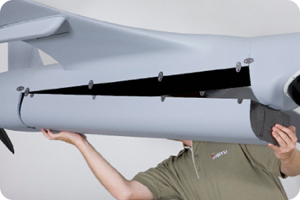
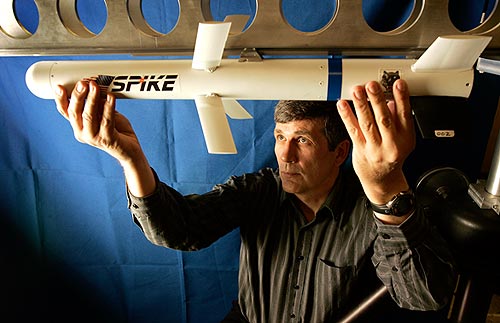
Shortened commando versions of the M224 60mm mortar should be fielded so dismounted infantry can immediately return or initiate fire against enemies. ATACS should be supplied to carry more mortar ammo when dismounted than manpacked.

The imagery relayed from the small UAV should go to flat screen TV displays inside their M1064A3 Gavins and on their "smart [cell] phones" [just like the Daniel Craig James Bond uses in movies and video games] strapped to their their forearms.
NOTES
www.flightglobal.com/blogs/the-dewline/2009/06/scan-eagle-cutaway-and-feature.html
RESPONSES TO THIS ARTICLE:
"Mike, excellent article! I'm sending it to all my Infantry Company and Bn Cdrs. We had mortar exevals during XXXX 98, and the Airborne 81mm mortar plt from XXXX PIR won. Did an Abn mass tac with XXXX Thu (12 C130s). The 81 plt air dropped 2 tubes, with ammo bundles, and had them in action 10 minutes after their PLF. I know, because I landed 25 meters from the mortar bundles, and watched these awesome guys do their thing -- the mortar platoon sergeant, real stud, broke his ankle in the jump.
Airborne!
Keep up the great work!
COL XXXX
